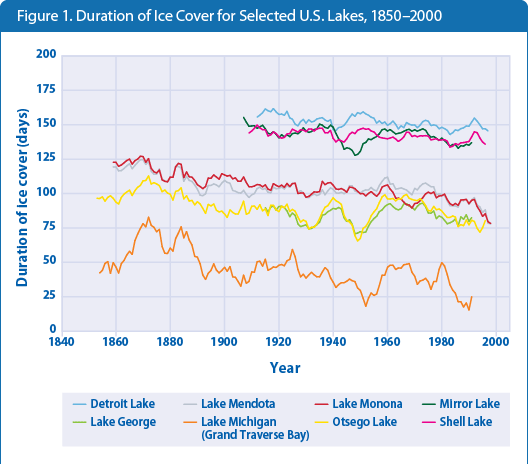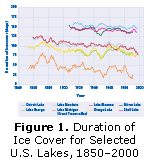Climate Change
Climate Change Indicators in the United States

This figure displays the duration (in days) of ice cover for eight U.S. lakes. The data are available from approximately 1850 to 2000, depending on the lake, and have been smoothed using a nine-year moving average.
Data source: NSIDC, 2009 2


This figure shows the "ice-on" date, or date of first freeze, for eight U.S. lakes. The data are available from approximately 1850 to 2000, depending on the lake, and have been smoothed using a nine-year moving average.
Data source: NSIDC, 2009 3


This figure shows the "ice-off" date, or date of ice thawing and breakup, for eight U.S. lakes. The data are available from approximately 1850 to 2000, depending on the lake, and have been smoothed using a nine-year moving average.
Data source: NSIDC, 2009 4

Key Points
- The time that lakes stay frozen has generally decreased since the mid-1800s. For most of the lakes in this indicator, the duration of ice cover has decreased at an average rate of one to two days per decade (see Figure 1).
- The lakes covered by this indicator are generally freezing later than they did in the past. Freeze dates have grown later at a rate of roughly half a day to one day per decade (see Figure 2).
- Thaw dates for most of these lakes show a general trend toward earlier ice breakup in the spring (see Figure 3).
- The changes in freeze and thaw dates shown here are consistent with other studies. For example, a broad study of lakes and rivers throughout the Northern Hemisphere found that since the mid-1800s, freeze dates have occurred later at an average rate of 5.8 days per 100 years, and thaw dates have occurred earlier at an average rate of 6.5 days per 100 years. 1
Background
The formation of ice cover on lakes in the winter and its disappearance the following spring depends on climate factors such as air temperature, cloud cover, and wind. Conditions such as heavy rains or snowmelt in locations upstream or elsewhere in the watershed also affect lake ice duration. Thus, ice formation and breakup dates are key indicators of climate change. If lakes remain frozen for longer periods, it can signify that the climate is cooling. Conversely, shorter periods of ice cover suggest a warming climate.
Changes in ice cover can affect the physical, chemical, and biological characteristics of a body of water. For example, ice influences heat and moisture transfers between a lake and the atmosphere. Reduced ice cover leads to increased evaporation and lower water levels, as well as an increase in water temperature and sunlight penetration. These changes, in turn, can affect plant and animal life cycles and the availability of suitable habitat. Additionally, ice cover affects the amount of heat that is reflected from the Earth's surface. Exposed water will absorb and retain heat, whereas an ice- and snow-covered lake will reflect the sun's energy rather than absorb it. (For more information on ice and snow reflecting sunlight, see the Snow Cover indicator.)
The timing and duration of ice cover on lakes and other bodies of water can also affect society—particularly shipping and transportation, hydroelectric power generation, and fishing. The impacts can be either positive or negative. For example, reduced ice cover on a large lake could extend the open-water shipping season, but require vessels to reduce their cargo capacity because of decreased water levels.
About the Indicator
This indicator analyzes the dates at which lakes freeze and thaw. Freeze dates are when a continuous and immobile ice cover forms over a body of water. Thaw dates are when the ice cover breaks up and open water becomes extensive.
Freeze and thaw dates have been recorded through visual observations for more than 150 years. The National Snow and Ice Data Center maintains a database with freeze and thaw observations from more than 700 lakes and rivers throughout the northern hemisphere. This indicator focuses on eight lakes within the United States that have the longest and most complete historical records. The lakes of interest are located in Minnesota, Wisconsin, Michigan, and New York.
Indicator Confidence
Although there is a lengthy historical record of freeze and thaw dates for a much larger set of lakes and rivers, some records are incomplete, ranging from brief lapses to large gaps in data. This indicator is limited to eight lakes with fairly complete historical records.
Data used in this indicator are all based on visual observations. Records based on visual observations by individuals are open to some interpretation and can differ from one individual to the next. In addition, historical observations for lakes have typically been made from the shore, which might not be representative of lakes as a whole or comparable to more recent satellite-based observations.
Data Sources
Data were obtained from the Global Lake and River Ice Phenology Database, which is maintained by the National Snow and Ice Data Center. These data are available at: http://nsidc.org/data/ lake_river_ice.
Indicator Documentation
- Download related technical information PDF (6 pp, 44K)





